Pennsylvania
| |
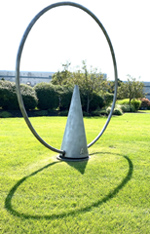 |
Philadelphia |
Pennsylvania |
USA |
Noon Mark or Meridian Dial |
Dial 1017 |
| This meridian dial titled "The Point Where Things Change" was commissioned by the Redevelopment Authority of the City of Philadelphia. It is a large 8-foot diameter hoop aligned north-south. The gray painted hoop is supported at its base, covered by a narrow steel sheet cone also painted gray. The meridian dial and cone are slightly raised above a concrete pad. During the morning the shadow climbs up the AM side of the cone, at noon it rests directly on the point, and in the afternoon it starts to descend down the PM side of the cone. The Redevelopment Authority budgeted $18,000 for the meridian dial as a public art project. |
| |
| |
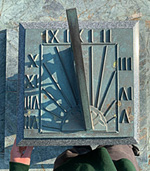 |
Philadelphia |
Pennsylvania |
USA |
Horizontal Dial |
Dial 1047 |
| In the middle of the Girard green in a large central plaza is an impressive stone dais with a square pillar rising several feet. On top is a 12-inch square dial with a smooth green patina. The dial has a wide gnomon offset to point to true north. The most striking thing is the Roman numerals that seem "upside down" from most horizontal dials. The reason is that most observers approach the dial from the north, making the dial easier to read. |
| |
| |
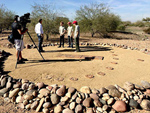 |
Phoenix |
Arizona |
USA |
Analemmatic Dial |
Dial 940 |
| On a trail of desert scrub is a cleared circular area, defined by a low pile of river stones as the border. Within is a titled analemmatic sundial about 30 feet across. The center walkway is made of sized adobe-red concrete tiles for each month. The abbreviation of each month is set into the tile. The matching hours on their elliptical arc are marked with small adobe-red concrete circles. |
| |
| |
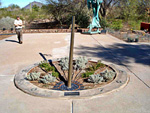 |
Phoenix |
Arizona |
USA |
Horizontal Dial |
Dial 578 |
| A 10 foot diameter horizontal dial with steel gnomon. Live desert plants fill planters delineated by hour lines. |
| |
| |
 |
Phoenix |
Arizona |
USA |
Vertical Dial |
Dial 772 |
| A dual-vertical cube dial with two 12 inch square dial plates declining 45? south of east and south of west. The east face shows hour lines for 6 AM to 12 PM; the west face shows hour lines for 12 PM to 6 PM. Roman numerals mark three hour lines on each face. |
| |
| |
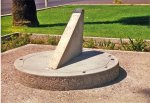 |
Phoenix |
Arizona |
USA |
Horizontal Dial |
Dial 7 |
| This large ground-level horizontal dial designed by Charles Keener. Dial is a circular concrete slab 62 in. diameter and 8 in. thick. The gnomon is 30 in. high, 41 in. substile, 55 in. stile. Dial has Roman numerals. Unfortunately, the 6AM and 8AM numerals are missing. Ground level dial composed of concrete slab 62 inch diameter and 8 inch thick. |
| |
| |
 |
Pinawa |
Manitoba |
Canada |
Horizontal Dial |
Dial 469 |
| The Pinawa Heritage Sundial located in the center of town was constructed as a city wide effort to create pride and focus. The 17.5 foot high horizontal sundial has a gnomon constructed of steel and the 38.5 by 40.5 foot base is constructed of polished granite, rail, and granite stones. The sundial has two sets of time markers. An outer dial ring indicates local apparent time, while an inner dial ring indicates zonal solar time. Forming an integral part of the sundial, 12 icons were designed and constructed, illustrating the history of the region and its people. |
| |
| |
 |
Pine Mountain |
Georgia |
USA |
Analemmatic Dial |
Dial 386 |
| Interactive analemmatic dial set in an herb garden. Visit website |
| |
| |
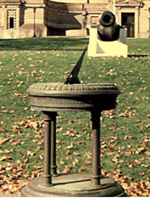 |
Pittsburgh |
Pennsylvania |
USA |
Horizontal Dial |
Dial 436 |
| Horizontal dial about 24 inches in diameter. The stone pedestal is decorated with bronze plaques and Veterans of Foreign War seals on each of the four sides. Now has an open metal base |
| |
| |
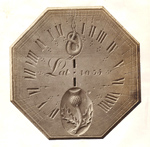 |
Pittsburgh |
Pennsylvania |
USA |
Horizontal Dial |
Dial 641 |
| A 12 inch octagonal carved sandstone horizontal dial with Roman hour numerals from 4 AM to 8 PM. The gnomon is missing. Dial face includes carved figures of a snake and a thistle and is marked latitude 40° 35'. The 1763 date ascribed to the dial's origin is coincident with the relief of the siege of Fort Pitt during Pontiac's Rebellion in that year. The 42nd and 77th Regiments of the Highland Guard and the 60th Regiment of the Royal Americans defeated the Native forces (Delaware, Shawnee, Mingo and Huron Tribes) at the Battle of Bushy Run in August, 1763, successfully quelling the Indian uprising in Southwestern Pennsylvania. The Highland Guard is artistically represented on the sundial by the thistle and the Royal Americans by the snake. Although the assignment of the 1763 date to the dial is not conclusive, the history of Fort Pitt, together with the design elements seen on the sundial and the location of its discovery, provides a plausible conclusion. |
| |
| |
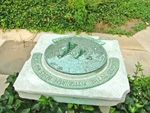 |
Pittsburgh |
Pennsylvania |
USA |
Horizontal Dial |
Dial 107 |
| In May of 1914, a beautiful sundial was erected in Schenley Park in memory of the Pittsburgh Blues, a company sent out from Pittsburgh. To remember this event Pennsylvania Chapters including the Keystone Chapter, Old Ironsides Chapter, General Robert Patterson Chapter, and the Stephen Decatur Chapter participated in the famous grave marking ceremonies which located, honored, and decorated hundreds of graves of men who served in the War of 1812 with custom made flags and flowers. |
| |
| |
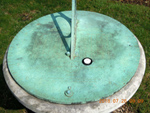 |
Pittsburgh |
Pennsylvania |
USA |
Horizontal Dial |
Dial 108 |
| A bronze and well patina circular horizontal dial about 18 inches in diameter. The dial is delineated in 10-minute increments with Arabic hour numbers. Dial sits atop a plain circular column. The gnomon is plain, secured to the dial plate with four bolts. |
| |
| |
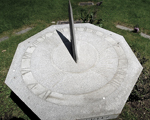 |
Pittsburgh |
Pennsylvania |
USA |
Horizontal Dial |
Dial 908 |
| This granite memorial octagonal sundial is approximately 5 feet across. The top is unadorned, containing only the delineated hour lines in 15 minute intervals and hour marks in Roman numerals from 5am-7pm. The gnomon has a sharp style |
| |
| |
 |
Pittsburgh |
Pennsylvania |
USA |
Sculpture/Artwork |
Dial 909 |
| The memorial is positioned and shaped to capture sunlight through its vertical spaces. While the sun travels the horizon, columns of light shine onto the ground, highlighting words engraved in the stone below that express individual and shared experiences about the war. |
| |
| |
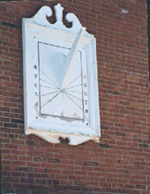 |
Pittsford |
New York |
USA |
Vertical Dial |
Dial 438 |
| This old vertical north facing dial in on the Spring House, constructed circa 1822. The building was an old Erie Canal Inn. The dial is about 48 inches high by 30 inches wide, made of wood and painted with a white boarder. The gnomon is also white painted wood and "looks upside down" because the dial faces north. The dial and gnomon have been repainted several times. |
| |
| |
|
Plymouth |
Massachusetts |
USA |
Horizontal Dial |
Dial 342 |
| approx. 8 feet in diameter Roman numerals, with half-hour marks and compass rose. Dial sits on a rectangular stone pedestal. |
| |
| |
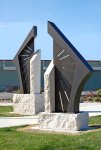 |
Pocatello |
Idaho |
USA |
Vertical Dial |
Dial 742 |
| A south-facing vertical dial split into two sculptures separated by a walking path. The dial faces are vertical powder coated steel sculptures with cut hour lines. The gnomons are travertine limestone blocks with the top edges pointing to celestial north. The edges of the gnomon stones cast the shadow onto the vertical dial faces. One dial face shows the morning hours, the other shows the afternoon hours. The gnomon styles extend to both sides of each dial face allowing extended time and season use.
This sculpture, "PASSAGE OF TIME," was commissioned by the City of Pocatello to represent Pocatello as the "Gate City," historically known as the gateway to the Snake River Plains. The meandering sidewalk path represents passage through both time and space. |
| |
| |
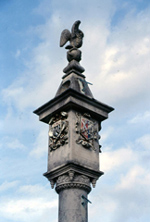 |
Pomfret |
Connecticut |
USA |
Pillar Dial |
Dial 84 |
| A 22 ft. high stone pillar dial built by William Ross Carpenter as a replica of the famous Charles Turnbull dial of Corpus Christi College in England dating from 1577. The pillar dial, called the Pelican dial, has multiple dials of various types. The Carpenter replica built in 1912 was restored in 1987. Ornate dial furniture with multiple inscriptions. A complex masterpiece. See the NASS Compendium Vol. 2 No. 1 for more details. |
| |
| |
 |
Port Arthur |
Texas |
USA |
Equatorial Dial |
Dial 446 |
| A large Erickson Monument polar equatorial dial of light colored granite, approximately 6 feet in diameter and 6 inches thick. The gnomon shaft is steel, extending from the ground through the dial plate and outward another two feet. The base is a simple tier of raised concrete. 24 hours are inscribed on each side of the dial (summer and winter) as radiating lines with Arabic numbers at the end. Time is graduated by half-hour and 5 minute marks. Two equation of time graphs, each about 3 x 6 feet engraved in granite, are set at the north and south ends of the dial, providing corrections from Apr-Sep, and Oct-Mar. [An interesting note about the engraving for the Apr-Sep graph: The line originally said "For daylight savings time, subtract one hour", the word "subtract" was filled in and "you add" was inscribed over it.] In the top quadrant of the dial (both obverse and reverse) where the sun's shadow will never cast, are the names of cities in 16 different Time Zones. A beautiful and well-crafted sundial, it makes a fitting Seaman's Memorial. |
| |
| |
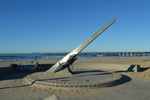 |
Port Hueneme |
California |
USA |
Horizontal Dial |
Dial 997 |
| A large, 20 ft. diameter horizontal bronze dial constructed in memory of Alaska Airlines Flight 261, which crashed 14 miles offshore nearby on January 31, 2000, with the loss of all aboard. 88 bronze plaques surround the dial on its beveled edge honoring passengers and crew who died. The dial face is simple without hour lines but Roman numerals from 8am to 4pm to mark the hours. The thin, gleaming gnomon is decorated with dolphins at the base symbolizing the sea into which the plane fell. The sundial is set in a circular plaza 36 feet in diameter. |
| |
| |
|
Port Richmond, Staten Island |
New York |
USA |
Vertical Dial |
Dial 142 |
| 17' H x 11' W x 8' D Painted steel with stainless steel wire cloth Noon mark and analemma features made of concrete and brass. |
| |
| |
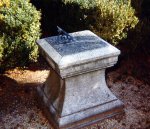 |
Portland |
Connecticut |
USA |
Horizontal Dial |
Dial 426 |
| An 18x18 inch square horizontal sundial with ornate engraving. Along the edge are Roman numerals telling the hours. The gnomon is equally ornate. Both dial plate and gnomon are made of brass. Dial sits on a tapered granite pedestal with a square granite cap. |
| |
| |
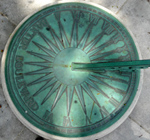 |
Portland |
Maine |
USA |
Horizontal Dial |
Dial 818 |
| A large 1m (3-foot) bronze sundial is set on a low granite dais at the center of a white granite ellipse. Surrounding the sundial are three white granite benches, the center declaring this as a memorial to Mayor James Baxter. The hour ring gives the hours from V in the morning to VII in the evening The ring is further divided into 15 minute increments. The dial has a large 24-point star and on the south end of the dial face the words "Baxter Boulevard". The artful gnomon is about 1-inch thick. Unfortunately the monument setting is heavily wooded and little sunlight reaches this fine dial. |
| |
| |
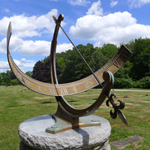 |
Portland |
Maine |
USA |
Equatorial Dial |
Dial 831 |
| Prominent in the cemetery is a large equatorial sundial about 4 ft in diameter. The dial was custom built for the location latitude and longitude. It is made of cast, anodized aluminum. The equatorial ring is 8-inch side arc with Roman numeral hours from VI to VI (6am to 6pm) with marks at 5 minute intervals. The scale is shifted to correct for longitude. The gnomon is an elegant arrow. It sits on a 4 ft plinth made of river stone, capped with a circular 6 inch block of polished granite. |
| |
| |
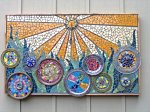 |
Portland |
Oregon |
USA |
Vertical Dial |
Dial 660 |
| A 4 x 2.5 foot south-facing vertical dial of mosaic tile whose hour lines include longitude correction. |
| |
| |
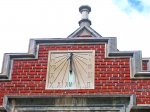 |
Portland |
Oregon |
USA |
Vertical Dial |
Dial 662 |
| A classic stone 20 x30 inch south facing vertical dial with bronze gnomon on brick building above sally port about 30 feet above grade. Hour lines with Roman numerals are corrected for longitude. Flanking the sally port are carved figures of Lux, or light, with open eyes on the east and Nox, or night, closing its eyes for sleep on the west. Reed College is a west coast "Ivy League" college following the Collegiate Gothic traditions of Oxford, Cambridge and the eastern US colleges. |
| |
| |
 |
Portsmouth |
New Hampshire |
USA |
Horizontal Dial |
Dial 130 |
| Octagonal, approx 6 in. on a side Brass/Bronze Center compass rose, 4AM-8PM in Roman numerals. Standard stone pedestal. Probably not the original, as it is oversize for the dial plate. |
| |
| |
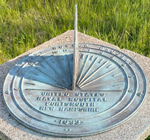 |
Portsmouth |
New Hampshire |
USA |
Horizontal Dial |
Dial 1082 |
| Farenholt sundial for U.S. Naval Hospital Portsmouth New Hampshire. This cast bronze dial was designed and commissioned by RADM Farenholt for U.S. Naval Hospitals at bases where he was commanding officer, visited, or had special meaning to him. The dial is 18 inches (46cm) in diameter. The outer chapter ring has the motto, followed by a chapter ring with Arabic hours 6am to 6pm, raised hour lines that radiate from near the foot of the gnomon and short half-hour lines. The gnomon has graceful curves and a star cut-out in the center. Below the gnomon is the naval command name, followed by the commissioning date in the southern portion of the hours chapter ring. |
| |
| |
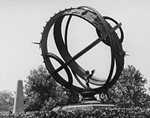 |
Potomac |
Maryland |
United States |
Armillary Sphere |
Dial 284 |
| The Noyes armillary sphere was donated by Bertha Noyes in honor of her sister, Edith. Made of copper and bronze, the 6-foot armillary had an equatorial band with symbols of the zodiac, a meridian circle and arctic & antarctic circles. A winged cherub — a putto — stood in the center. The dial sat upon a octagonal polished green granite base. |
| |
| |
 |
Poughkeepsie |
New York |
USA |
Horizontal Dial |
Dial 412 |
| Small horizontal brass dial, about 12 inches in diameter with classical design. Roman numerals for hours with dots for quarter and half hours. Sits on fluted column about 3 foot high. Beautifully set in the Shakespeare Garden. |
| |
| |
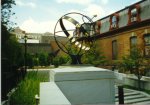 |
Poughkeepsie |
New York |
USA |
Armillary Sphere |
Dial 165 |
| Built by Kenneth Lynch & Sons, Wilton CT |
| |
| |
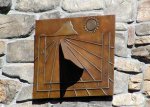 |
Prescott |
Arizona |
USA |
Vertical Dial |
Dial 585 |
| An 18x20 inch cast bronze vertical dial declining 22? west of south on the wall of a private home. Dial face includes a stylized sun and outline of Thumb Butte, a prominent local landmark. Dial can be viewed by first contacting the owner. |
| |
| |
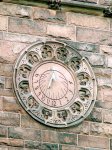 |
Princeton |
New Jersey |
USA |
Vertical Dial |
Dial 590 |
| Circular vertical dial about 10 foot diameter on stone wall with bronze gnomon and substyle. Dial declines 23° east of south. Hour lines every half hour. Arabic hour numerals with 12 Zodiacal signs. |
| |
| |
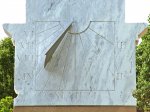 |
Princeton |
New Jersey |
USA |
Vertical Dial |
Dial 591 |
| White marble 5x5 foot vertical dial declines 23° E with metal gnomon. Sits atop 12 foot cement pillar. Hour lines with Roman numerals are shown for every hour from 6 AM to 3 PM. North side of dial face depicts a tiger; donators Lee & Margaret Butler are named below with date 1983. |
| |
| |
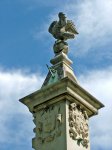 |
Princeton |
New Jersey |
USA |
Pillar Dial |
Dial 339 |
| A 22 ft high stone pillar dial, given by Sir William Mather, governor of Victoria University, Manchester, England, in 1907. It is a reproduction of the famous Turnbull dial of Corpus Christi College in England. This replica is the same as the one at Pomfret School, in CT. (#84). It was unveiled by Woodrow Wilson in 1907. |
| |
| |
 |
Providence |
Rhode Island |
USA |
Noon Mark or Meridian Dial |
Dial 949 |
| At first glance this is a gleaming stainless steel sculpture 15 feet long by 4 feet high in the shape of a Mobius strip. Although it fits its name "Infinity Possibility", it also contains a meridian noon mark sundial. At the south end of the Mobius, high up on its curved surface is a hole to allow the noontime sun to create a beam of light that hits a lower portion of the Mobius strip. Engraved on the strip is an analemma adjusted for the longitude of Brown University that shows date and civil time throughout the year. The analemma has monthly markers and is delineated with ticks every 5 days. |
| |
| |
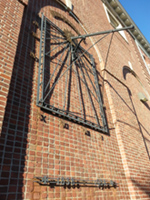 |
Providence |
Rhode Island |
USA |
Vertical Dial |
Dial 857 |
| The vertical dial is a metal frame approximately 4 x 5 feet set high on a brick wall. Within the frame are metal hour lines from 6am to 5pm marked by Roman numerals. The hour lines are adjusted for the dial's longitude to show time for the 75th meridian. Metal lines for the solstices and equinox are set for the shadow of a small spherical nodus on the gnomon rod. The gnomon itself is anchored to a bronze plate stylized as the Sun. |
| |
| |
 |
Providence |
Rhode Island |
USA |
Vertical Dial |
Dial 858 |
| The 3 x 4 foot vertical dial is set high in the ashlar sandstone wall of Wilson Hall, the original Physics Building. In the middle of the dial is the Brown University shield, holding the gnomon rod. Surrounding the shield are hour lines. In the original 1890 architect's drawing, the hour marks were Arabic numbers from 6am to 6pm, but as built, the numbers were engraved Roman numerals and set inside the hour lines. Half hour marks were added as well. No longitude offset is made such that the noon hour line is vertical. |
| |
| |
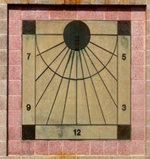 |
Providence |
Rhode Island |
USA |
Vertical Dial |
Dial 859 |
| This is a traditional vertical dial approximately 4 x 6 feet. The dial is surrounded by a row of square pink concrete brick. The dial backdrop itself is concrete with decorative dark block squares in each corner. The dial consists of a simple metal frame with hour lines that radiate from a small top central circle, all well proportioned. Hours of 7, 9, 12, 3, and 5 are marked with Arabic numbers, keeping the dial face simple. No solstice or equinox lines, but there is an artistic circular arc surrounding the central circle. Unfortunately the rod gnomon is completely missing. |
| |
| |
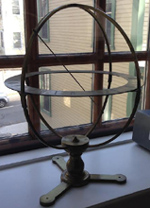 |
Providence |
Rhode Island |
USA |
Armillary Sphere |
Dial 860 |
| This 18th century dial is made by Benjamin Martin an instrument maker in London. It is bronze, approximately 18 inches in diameter. The gnomon rod is held by an meridian circle attached to a heavy bronze pedestal with three legs. The horizontal time ring, held by the meridian ring and an east-west ring as well, is engraved with Roman numerals. |
| |
| |
 |
Pueblo |
Colorado |
USA |
Sun Alignment |
Dial 200 |
| Stonehenge type dial designed by Judy Guttormsen and built in 1984 . Stonehenge itself an amphitheater. If you stand on a brass marker in the center of the stage, on the solstices and equinoxes, you can observe the rising and setting of the sun aligned with metal posts viewed through slits in the wall. At the south edge of the site is a 6 foot horizontal dial laid out in the concrete floor. There are two rings of numbers, one for standard time, one for daylight time. Not corrected for longitude, but the location is very close to the center of the time zone. The gnomon is cement and is unusually thick (approximately 40 cm), making it very sturdy, presumably to prevent vandalism. The surface of the gnomon is very rough, having embedded pebbles, making it an uncomfortable place to sit or climb. The metal inscription plate on the gnomon has faded too badly to read. The site also has a North Star finder made of wrought iron and has a small bench for children to use. |
| |
| |
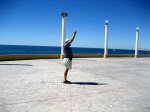 |
Puerto Penasco |
Sonora |
Mexico |
Analemmatic Dial |
Dial 600 |
| A concrete analemmatic dial set in the El Camaronero Plaza on the Sea of Cortez. The dial is 20 feet E-W across the hour markers. The dateline displays the 1st, 10th and 20th of each month. Dial includes 34 minutes longitude correction. Instructions in Spanish and English are displayed nearby. |
| |
| |
 |
Punta Gorda |
Florida |
USA |
Horizontal Dial |
Dial 721 |
| A monumental sculpture of steel and stone including a 12 foot diameter horizontal dial with six foot high gnomon. Stone dial face includes hour markers and Roman hour numerals. Titled Spirit of Punta Gorda, the sculpture is dedicated to the spirit of the people of Punta Gorda in the aftermath of Hurricane Charlie on August 13, 2004. Two nearby bronze plaques identify and dedicate the sculpture. |
| |
| |
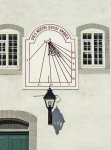 |
Quebec |
Quebec |
Canada |
Vertical Dial |
Dial 87 |
| Vertical dial on a board, about 1.5m high by 1 m wide. White with red lettering. It is placed above a doorway on an interior courtyard of the old Seminary, founded in 1663 by Mgr de Laval. The building now houses the architecture school of the Laval University. Although the school and Seminary buildings are private, access is available to the courtyard. |
| |
| |
 |
Queens |
New York |
USA |
Vertical Dial |
Dial 246 |
| A vertical dial on the cupola above the main entrance. Declination 70° 12' 04" E. Painted all white so that no hour lines can be seen. |
| |
| |
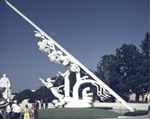 |
Queens |
New York |
USA |
Horizontal Dial |
Dial 247 |
| Paul Manship was commissioned to make the sundial for the 1939 World's Fair in New York. The dial was named "Time and the Fates of Man." Manship wrote, "The Perisphere and Trylon at the World's Fair suggests to me measurements of time and space, so my sundial… relates to the background of the central motif of the Fair." His white plaster sculpture was the biggest sundial in the world, standing 80 feet tall. |
| |
| |
 |
Queens |
New York |
USA |
Vertical Dial |
Dial 409 |
| A 20 foot high x 15 foot wide x 4 foot deep painted aluminum vertical dial entitled '"Winged Shadows." Has declination lines for the solstices and equinoxes. Declines west. On the back wall of the Main Building. Can be viewed from Woodside Ave. Designed by Robert Adzema in 1987. |
| |
| |
 |
Queens |
New York |
USA |
Sculpture/Artwork |
Dial 592 |
| A 6 foot diameter bronze sculpture reclined 50° (latitude is 40° 45' N) with slit gnomon and hour marks. Gift of Joan and Richard Scheuer in 2000. More sculpture than sundial, it does have some hour marks but reclines and appears to be out-of-plane. |
| |
| |
 |
Quincy |
Illinois |
USA |
Analemmatic Dial |
Dial 784 |
| A 10 foot x 18 foot analemmatic dial built of Keystone Blue granite from the quarry in Elberton, Georgia. Hour markers for 7 AM to 5 PM show Arabic numerals and identify the organizations donating to fund the dial. Each hour marker depicts the morphology of a leaf from a tree located in the nearby arboretum. The hour markers are 15 inches in diameter and 6 inches thick, weigh 102 pounds each and are placed flush with the soil to reduce potential for vandalism. |
| |
| |
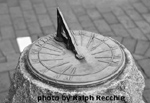 |
Raleigh |
North Carolina |
USA |
Horizontal Dial |
Dial 864 |
| Known as the Primrose Sundial, the bronze dial plate is a little more than a foot in diameter and sits on a small stone pillar about four feet high. The dial has simple hour lines from 4am to 8pm marked on the hour in Roman numerals. The open bronze gnomon is about 1/2 inch thick, held by both tenon and two large screws. |
| |